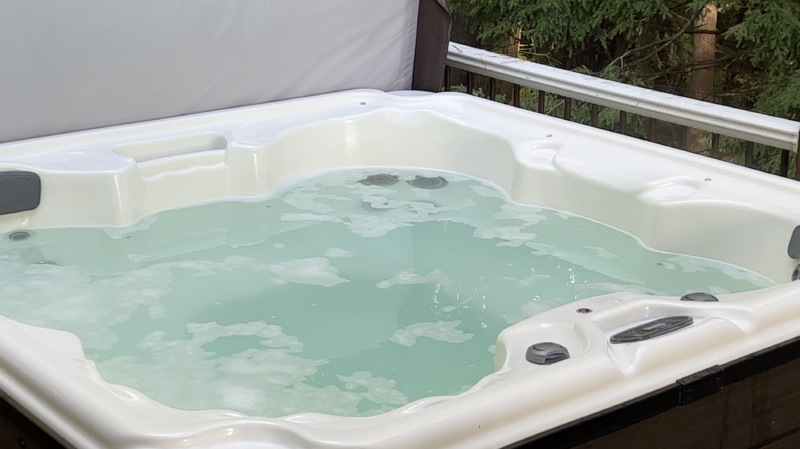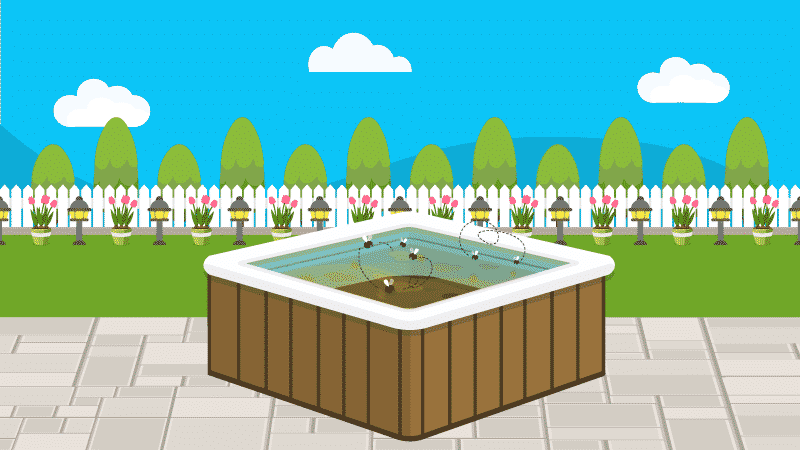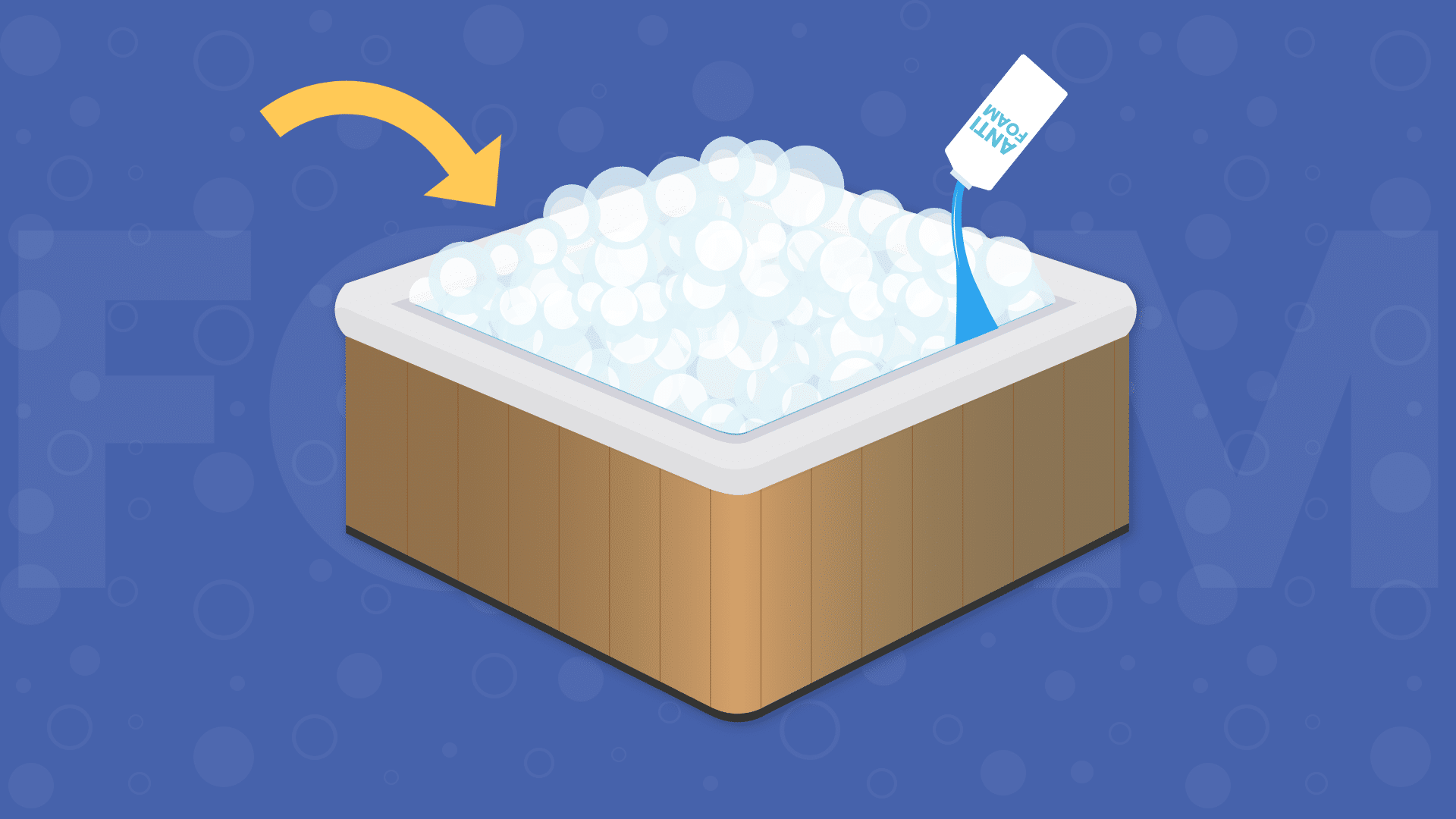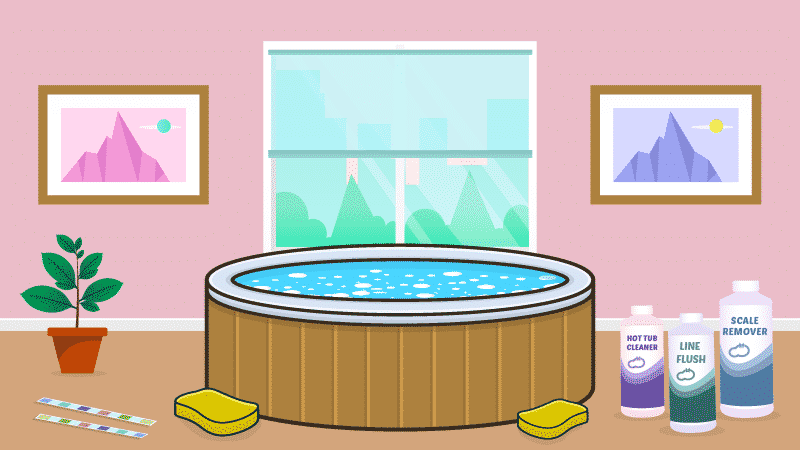How to Clear Cloudy Hot Tub Water
If you’re a hot tub owner, chances are you’ve dealt with cloudy water at some point. Cloudy hot tub water is caused by six common issues:
- Contaminants like debris or algae
- Low chlorine or bromine
- High pH levels or Alkalinity
- High metal or mineral levels
- Biofilm buildup
- Poor filtration
While some of these root causes are easy to fix (like low chlorine levels), others require a more hands-on approach to solve (like removing biofilm buildup in your pipes). In most cases, you can clear up cloudy, hot tub water by cleaning your filter, balancing your pH and alkalinity, and then adding shock.

This entire process usually takes one hour. But if you haven’t drained and cleaned your hot tub in a while, you might have a deeper issue, like biofilm buildup inside your plumbing.
Regardless of the reason, clearing up cloudiness is a relatively straightforward process. So here’s a step-by-step guide on how to clear cloudy, hot tub water in a few quick steps.
Table of Contents
6 Causes of Cloudy Hot Tub Water
From microscopic algae spores to hidden gunk inside your pipes, cloudy hot tub water is usually caused by poor water chemistry or outside contaminants. Here’s how to troubleshoot each of the common causes of cloudy, hot tub water.
1. Contaminants like Debris or Algae
Small particles, dead leaves, grass, and other debris in your hot tub can cause cloudy water. The more contaminants in your water, the harder your chlorine or bromine has to work. And if your sanitizer isn’t able to keep up with the contaminant load, you’ll start to see cloudy water.
The early-stage algae growth can also cause cloudy hot tub water. And weirdly enough, your water can cloud up if you’ve just used chlorine shock to kill algae. That’s because any dead algae killed by the shock will float around in your water until it’s filtered out.
SOLUTION: Test and balance your water and run your filter regularly, especially when you see debris or pollen in your hot tub. Kill early-stage algae by shocking your hot tub water with chlorine shock. And use non-chlorine shock once a week to keep your sanitizer refreshed and working properly. Finally, keep your hot tub covered when it’s not in use to protect it from debris.
Also known as oxidizer, non-chlorine hot tub shock helps revitalize your chlorine or bromine so it can actively sanitize your water. Use an oxidizer at least once a week but ideally after each hot tub soak to keep your water sanitized.
2. Low Chlorine or Bromine
If you use your hot tub frequently or you recently had a lot of people in the water, your sanitizer might not be able to keep up with the amount of contaminants. Body oils, shampoo, and even dead skin cells build up in your water after each use. And that means your chlorine or bromine will need to work over time.
So, if you notice cloudy water after an increase in hot tub use, your chlorine or bromine levels might be too low. And when you don’t have enough chlorine or bromine to sanitize your hot tub effectively, those contaminants linger and cause cloudy water.
SOLUTION: Test and balance your hot tub water once a week, especially after heavy use. Shock your water with non-chlorine shock once a week to help revitalize your sanitizer. And shock with a chlorine-based shock after heavy use or if your chlorine levels are chronically low.
3. High pH or Alkalinity Levels
High pH and Alkalinity can cause scale to form on your hot tub surfaces and inside your plumbing. This can lead to poor filtration, bacteria growth, and cloudy water.
And poor water chemistry makes it more difficult for your chlorine or bromine to function well and kill contaminants. Your pH should be between 7.4 and 7.6, and your alkalinity should be between 100 to 150 PPM (80 PPM is okay).
SOLUTION: Test and balance your total alkalinity and pH regularly. Balancing alkalinity first will help stabilize your pH. Use a
Lower your hot tub pH with a pH decreaser. High pH can damage your hot tub equipment, cause cloudy water, and irritate eyes and skin.
4. High Metal or Mineral Levels
Over the long term, filling your hot tub with water that contains high levels of metal can stain your surfaces and cause murky, cloudy water. High calcium levels from hard water can also cause cloudiness. Your hot tub’s calcium hardness levels should be between 175 to 250 ppm. If your calcium is too high, you’ll see scale buildup and cloudy water.
SOLUTION: Use a hose filter when filling your hot tub. Add a metal sequestrant before other water chemicals if you have high levels of metal in your water.
5. Biofilm Buildup
Contaminants like sweat, body oils, lotions, detergents, and bacteria can build up over time inside your hot tub plumbing. After several months, it starts to form a protective layer called biofilm, and it becomes resistant to your normal chemicals.
That means chlorine, bromine, or even shock won’t clean out your hot tub pipes. And every time water passes through your plumbing, that gunk circulates back into your hot tub and causes cloudy water.
SOLUTION: The only way to remove biofilm in your pipes is with a hot tub
Don't let your hot tub fill with hard-to-remove gunk. Clear out the gunk and keep your hot tub water fresh. It removes gunk in your pipes caused by lotions, sunscreens, cosmetics, etc.
6. Poor Filtration
As your hot tub water circulates and passes through your filtration system, the filter captures larger particles and contaminants. But if your filter is dirty or not properly installed, those particles will remain suspended in your hot tub water, slowly decomposing, leaving your water cloudy and dirty.
SOLUTION: Spary your filter cartridge once a week with a garden hose, and once per month, spray it with a filter cleanse. Make sure the filter cartridge is properly secured in the filter well. And replace your filter once it becomes worn out or can no longer be cleaned.
Soak your hot tub filters in this deep-cleaning solution, rinse with water, and your filters will look brand new in 24 hours!
How to Clear Up Cloudy Hot Tub Water in Just One Hour
Luckily, clearing up cloudy hot tub water is a relatively simple process and the hands-on work only takes about an hour. Start with the easiest steps first to see if your water clears up before moving on to more complex troubleshooting, like draining your hot tub and purging your pipes.
At any point in the process, you can add a hot tub water clarifier to clear up your water immediately. But keep in mind this only fixes the symptom, not the cause of the cloudiness. The problem will return if you don’t take steps to clean your filter, balance your water chemistry, or shock your hot tub.
1. Clean Your Filter
If your filter is too dirty or it’s not properly sitting in the filter well, it won’t be able to pick up small particles causing cloudy water. Clean your filter by removing the cartridge and spraying it with a hose. Once a month, spray it with a filter cleanse. If the filter pleats are ripped or damaged, it may be time to replace the filter altogether.
Just be sure to rinse your new clean filter cartridge with a hose before adding it to your hot tub. Always keep two filter cartridges on hand so you can replace the one soaking with a clean cartridge.
2. Test and Balance Alkalinity, pH, and Sanitizer Levels
Remove the hot tub cover and test your water with test strips or a liquid test kit. If needed, start by balancing your total alkalinity first since this will help stabilize your pH. Your alkalinity should be between 100 and 150 PPM (80 PPM is okay). Then, adjust your pH, which should be between 7.4 and 7.6.
To bring these into range levels, you’ll need to add
3. Add Chlorine Shock
Chlorine shock is a highly concentrated dose of chlorine that will kill any lingering contaminants causing cloudiness. And chlorine shock can be used in both chlorine or bromine hot tubs. Just never mix bromine and chlorine chemicals together outside of your hot tub.
A chlorine-based hot tub shock helps treat cloudy water, kill bacteria and algae, and remove contaminants after heavy hot tub usage. This formula also contains an oxidizer, which will help break apart any combined chlorine or bromine that's been used up in the water.
Start by running your hot tub with the cover off. Then, add your chlorine shock, following the manufacturer’s instructions. Wait at least 20 minutes, and then retest your water. Your chlorine levels should be between 1 and 3 PPM, with 3 PPM being ideal.
Once your chlorine drops back into the normal range, you can use your hot tub. And if you have a bromine hot tub, now’s the time to adjust your bromine levels, if necessary (your bromine should be between 3 and 5 PPM.)
4. Keep the Hot Tub Running
Keep the hot tub running and filtering 24/7 for at least one day to remove any lingering contaminants. And make sure your water is circulating regularly throughout the week.
All of your hot tub water should pass through your filtration system twice a day. Whether you run it manually or you’ve programmed your hot tub to run automatic filter cycles, be sure you’re doing so often enough to clear contaminants.
What If My Hot Tub is Still Cloudy?
If following these steps doesn’t clear up your hot tub, you’ve likely got a larger underlying issue, such as metals or minerals in your water source or biofilm in your plumbing.
1. Remove Metals and Minerals
If your clean water source contains metals, you’ll want to start using a metal sequestrant. This chemical binds with the metal in your water, preventing it from discoloring and clouding up your hot tub water. You’ll need to add it both when refilling and as regular hot tub maintenance.
And always use a pre-filter on your garden hose when refilling your hot tub. This will help remove minerals, like calcium, that can cause cloudiness.
2. Flush Your Hot Tub Lines
If you haven’t drained and cleaned your hot tub in a while, you likely have biofilm built up inside the pipes, causing cloudy water. Plan to drain and refill your hot tub every 3 to 4 months.
Before draining your hot tub, add a hot tub
Check out our complete guide on How to Drain and Clean a Hot Tub if you need more help.
3. Add a Water Clarifier
Water clarifiers bind tiny particles that cause cloudy spa water into larger particles. These larger particles are easier for your spa filter to remove when the water circulates.
This step is optional. But if you continue to use a little bit of clarifier for weekly water care, this will help keep your water crystal clear.
This weekly hot tub treatment cleans, conditions, and makes your water clear all at once. It stops gunk from building up in your pipes and jets while making the water feel soft and silky. Just add a little bit with the jets on high to keep any type of hot tub fresh and clean.
How to Prevent Cloudy Hot Tub Water
Once you’ve cleared up your cloudy water, follow these best practices to keep your hot tub water clean and clear:
- Fill your hot tub with filtered water. Use a hose filter whenever you’re adding fresh water to your hot tub. This will help remove metals and minerals.
- Test and balance your water chemistry weekly. Make sure your alkalinity, pH, and chlorine or bromine are within range. High alkalinity and pH (and low sanitizer levels) can cause cloudy water.
- Shock your water weekly. Adding a non-chlorine shock to your hot tub after each use or at least once a week can help keep your sanitizer active and working.
- Keep your filter clean. Depending on how much you use your hot tub, spray your filter with a hose once per week and a filter cleanse once per month. Keep an extra cartridge on hand to replace your dirty cartridge while you clean or soak your filter.
- Flush your hot tub plumbing every 3 to 4 months. Use a
line flush product with every water change to clear your hot tub plumbing and keep biofilm in check. This is when you’ll want to soak your filters in a filter cleanse, too.
Frequently Asked Questions About Cloudy Hot Tub Water
Looking for more help clearing up your cloudy hot tub? Here are some common questions and answers.
How long does it take for a cloudy hot tub to clear?
Clearing up your cloudy hot tub water is a relatively straightforward process. Cleaning your filter, balancing your pH and alkalinity, and shocking your water should take about one hour. If you haven’t flushed your hot tub plumbing in a while, that may be the cause of your cloudy water and will require more work. Using a hot tub line flush, draining, and then refilling your hot tub can take several hours.
What if my hot tub is cloudy, but my chemical levels are fine?
If your hot tub water is cloudy but your chemical balance is correct, there are three likely reasons why:
- Your filter needs cleaning. A dirty filter can cause cloudy water, so rinse your filter regularly or use a filter cleaner.
- You just shocked your water. After shocking a hot tub with chlorine shock, it’s not uncommon to see dead algae floating and clouding up your water. Running your filter will help remove these particles after shocking.
- You’ve got contaminants or debris. Scoop out debris with your hands or a skimmer net and keep your filters running to remove smaller particles. And rinse your feet before entering the hot tub to prevent dirt or grass from getting in the water.
- You have biofilm built up in the plumbing. Use a hot tub line flush every 3 to 4 months, and then drain and refill your hot tub.
Can you use a hot tub if it’s cloudy?
It’s less sanitary to use a hot tub when the water is cloudy. Cloudy, hot tub water is usually a sign that the water is full of contaminants or that the sanitizer levels are low.
Why is my hot tub cloudy after I use shock?
Adding chlorine shock to a hot tub can cause temporary cloudiness as it kills contaminants like algae. This usually dissipates over time as your filter runs. High pH and alkalinity can also cause cloudy water, so be sure to retest your hot tub before and after shocking.
Will a cloudy hot tub clear on its own?
If your filter is clean and running, your pH, alkalinity, and chlorine or bromine levels are in range, and you don’t have any biofilm buildup in your pipes, your cloudy hot tub water will likely clear up on its own. If not, shock your water. Finally, you can also use a hot tub clarifier to help speed this up and keep the water sparkling clear.
3 More Ways We Can Help With Your Hot Tub
- Hot Tub Cheat Sheets (Free): Easy-to-use guides to help you keep your hot tub water balanced and sanitized.
- The Hot Tub Handbook: An illustrated guide to DIY hot tub care, including water chemistry, maintenance, troubleshooting, and more.
- The Hot Tub Care Course. You’ll get step-by-step videos and a step-by-step downloadable guide with everything you need to know about hot tub maintenance.















